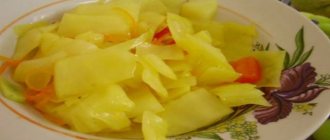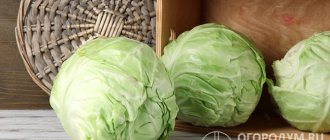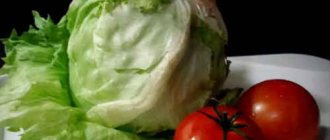Choosing cabbage for fermentation
The most suitable cabbage for fermentation is late and mid-late varieties with dense heads of cabbage. Mid-late cabbage ripens by the end of summer or early autumn, and late cabbage by the end of October. Early varieties are not suitable due to the looseness and green color of the leaves. In addition, such cabbage is low in sugars, which are important for normal fermentation. Late varieties are sweet and juicy, and this is important for making sauerkraut crispy. Before fermenting, be sure to taste the cabbage and make sure it is not bitter. Squeeze a few leaves - if the juice comes out, then the cabbage is good for your purposes!
Heads of cabbage should weigh at least 1 kg, since the larger the cabbage, the richer it is in vitamins and microelements.
Carefully inspect the cabbage leaves and stalks - there should be no stains or traces of pests on them. In this case, the stalk should not be longer than 3 cm.
https://youtu.be/RBRL3UfvT5w
Recipe for sauerkraut in a barrel without brine with sugar
If you have a wooden barrel, then use it to ferment vegetables, as our grandmothers did. This recipe uses black bread to speed up the fermentation process, which adds a pleasant aroma to the finished snack. Take only late varieties of cabbage, and when ready, store it in a cold place, but make sure that the temperature does not fall below zero degrees.
Ingredients:
- cabbage - 10 kg
- carrots - 1 kg
- salt - 250 gr.
- sugar - 50 gr.
- black peppercorns - 15 gr.
- rye bread - 50 gr.
1. The barrel needs to be prepared in advance. To do this, wash it and fill it with warm water (up to 40 degrees) overnight. This way the wood will swell and be as airtight as possible.
2.Now proceed to the most labor-intensive process - chopping the vegetables. The cabbage needs to be chopped, but not too finely or thinly, otherwise it will be too soft when finished. Grate the carrots on a coarse grater or cut into strips using a food processor.
Do not chop all the vegetables at once, do it in parts and mix, as the volume is large.
3. Now you have chopped one cabbage (without the top leaves and stalks) - put the pieces in a basin (a little more than kg). Add a couple of carrots, a tablespoon of salt and a teaspoon of sugar. Also add 3-5 peppercorns. Mix with your hands and you can try. If you want, add salt or sweeten to taste.
Sauerkraut: secrets and subtleties
There are different recipes for sauerkraut, classic or more innovative, but the subtleties of preparation are not particularly different. The main thing is to remember them while you cook!
Take coarse salt, its quantity is calculated simply - for 1 kg of cabbage you will need about 1 tbsp. l. salt, but you can increase or decrease the amount depending on your taste preferences. To speed up the fermentation process, sugar is also added to the cabbage - approximately 0.5 tsp. for 1 kg of cabbage. And don’t forget about spices - bay leaf, allspice, currant leaves, sprigs of dill with seeds or horseradish.
Cabbage is fermented in shredded form, in quarters, halves and even whole heads. Don't cut it too finely, otherwise it will be soft when finished, but we want it crispy. The ideal thickness of the pieces is 5 mm. That is why many housewives do not use vegetable cutters and a food processor, but chop them with a knife.
Sauerkraut
Sauerkraut is an ancient way of preparing cabbage for the winter.
Methods for preserving cabbage can be divided into 2 groups:
- pickling, or fermentation,
- and marinating.
The main ingredients of sauerkraut are cabbage and salt, the rest is added to taste.
Marinating - occurs with the addition of vinegar.
In short, I will not share personal recipes for sauerkraut.
Surely there are more experienced housewives at YAM who pass on recipes for pickling cabbage from generation to generation. I'm at the experimental stage.
I will try to summarize the information I know, with my comments, so that you, the readers, can decide for yourself what is interesting to you, or share your secrets and favorite recipes for salted cabbage.
1) Each region of Russia (and other countries) has its own traditions, its own favorite additions to sauerkraut.
2) To harvest cabbage, take mid-season and late varieties of cabbage. Cabbage for pickling should be large, white, and sweetish in taste. Late varieties have more sugars, which ensures better fermentation. Here again, each region has its own favorite varieties of cabbage. In central Russia, as it turned out, cabbage of the Slava variety is held in high esteem. Podarok and Moscow late varieties are popular in my region.
3) What should you salt the cabbage in? There is a lot of talk about oak barrels.
But again, at present we can order any pickling container. And in the past, housewives used barrels made from the material that grew in their area. Cabbage is fermented in oak, birch, linden, and cedar barrels. This is a matter of taste, wealth and wallet. Glass jars, stainless steel utensils and enamel containers are also used.
4) Salted/sauerkraut is basically shredded cabbage with salt and sometimes various additives.
There is no ideal proportion of salt to cabbage)) I have come across proportions from 200 grams. and up to 400 gr. salt, per 10 kg. cabbage, not necessarily iodized, preferably coarsely ground. We add 300 gr. salt per 10 kg. cabbage
- add sugar, honey, up to 100 g. by 10 kg. cabbage
- garlic, horseradish root,
- spices (bay leaf, dill seeds, coriander, cumin, black or red pepper, etc.)
- carrots, beets. Taste. Approximately 1 medium carrot or beet for 1 large cabbage.
- lingonberries or cranberries. About 2 liters per 10 kg.
- apples of late varieties, hard and sour, whole or in pieces
— in some regions they add whole cucumbers, turnips, Jerusalem artichokes, rutabaga, in pieces.
5) The process of fermenting cabbage involves chopping the cabbage and grinding it with salt. But this is the main option)) Again, you can salt the cabbage in quarters or eighths, or in large pieces, pouring brine, or in a large saucepan or barrel, transfer shredded cabbage and quarters of forks.
There are a lot of options.
Again, there is no single correct option for chopping cabbage))
Some cut cabbage with a knife, others with a grater, others use a shredder or special attachments in meat grinders and other household appliances.
Historically, cabbage was chopped in wooden troughs:
Modern version
Cabbage cut with a knife produces less juice when grated with salt; when chopped with a shredder, more juice is obtained. Depending on who and how will grind and compact the cabbage, different amounts of juice will be released.
Carrots and other things are usually added to cabbage after the cabbage has been grated with salt and has yielded juice. Stir, grind a little, but less actively.
Then the cabbage is placed in a pan or other container, compacted, a plate is placed on top and a bend, or something similar.
You can place whole large outer leaves on the top layer of cabbage, then a circle for bending, then bending.
Interesting design of the oppression - I liked it.
Usually the juice immediately appears above the pressure level. Several times a day, the cabbage should be pierced with a long, clean stick to release the gas. Most likely there will be foam during the fermentation process. The cabbage is ready when the foaming stops, the brine becomes clear, and the cabbage acquires a familiar pickled smell. After this, it can be placed in the cold, at a temperature of approximately 0-+3 degrees. Typically, the process of fermenting cabbage takes from three days and no more than a week.
Again, there is no uniform opinion on whether cabbage can be frozen. But vitamins are lost after freezing; many note that the taste changes and the cabbage is no longer so crunchy. Therefore, freezing cabbage is more impossible than possible.
Additional Information.
The “beautiful” cabbage is salted by removing spoiled leaves, spots, top leaves and stalks. Large cabbage produces less waste. Therefore, they usually try to salt large forks.
It is believed that the upper leaves and stalk contain the maximum amount of nitrates.
Counts. that the most delicious cabbage was made for the waxing moon. In November 2016, the waxing moon ends on November 13, and begins only on November 30.
Folk omens do not recommend fermenting cabbage on days of women's ailments.
It is believed that the most delicious cabbage is made on men's days - Monday, Tuesday, Thursday.
My personal little achievements.
I can't grow cabbage. I plant it, but it’s small... I don’t have pigs or chickens, and I don’t mind putting cabbage in the compost. My head of cabbage is soft, almost entirely made of green leaves. . Therefore, I buy the bulk of cabbage for pickling. In my region, autumn cabbage is “correct”, not green, but pickled. But as a zealous housewife, I don’t have the willpower to throw out my “wrong” small and untied cabbage. The main hard outer leaves are removed, and then I cut the soft forks into quarters or large pieces, add everything that I add to the borscht - beets, carrots, spices, garlic, and fill it with brine. Salt is taken by weight, 300 g. per 10 kg., and water as needed. When the cabbage is pickled, I transfer it to glass jars and add it to the borscht. Beets dull the green color of the leaves, spices mask the bitterness of the green forks. This is not quite the “correct” cabbage, it’s not for everyone. But nevertheless, if you feel sorry for your efforts and are ready to experiment, you can try.
And now, for a snack, about the benefits and harms of sauerkraut:
Sauerkraut contains the same beneficial substances as fresh white cabbage, these are: potassium, sodium, calcium, iron, sulfur, phosphorus, zinc, boron, selenium, copper.
But there are more vitamins in sauerkraut, this applies to vitamin C and B. By the way, in cabbage salted with whole heads of cabbage, about 1.5-2 times more vitamins are retained than in cabbage shredded into thin strips.
No vegetable has such a feature as cabbage; only cabbage, when fermented, is capable of retaining vitamin C in the same concentration for a long time. The secret of this is that it is in cabbage that vitamin C is found both in pure form and in chemically bound form.
During the fermentation process, cabbage is enriched with organic acids, primarily lactic and acetic. When fermenting cabbage, lactic acid bacteria create new vitamins, such as B12, and increase the amount of existing vitamins: B1, B2, B3, B6 and B9.
Potassium contained in sauerkraut is important as a preventive element against the formation of stones in the body, for the functioning of the heart and other muscles. Potassium relieves muscle spasms, normalizes heart rhythm, strengthens nerve cells, and normalizes blood pressure. And it is by spring that the body begins to lack potassium. By eating sauerkraut, we get not only a huge amount of vitamin C, but also a noticeable amount of potassium, as well as quite a lot of calcium, phosphorus, a lot of sodium and a little bit of iron.
The bacteria that take part in the ripening of cabbage, when they enter the stomach, have a beneficial effect on its functioning. They suppress pathogenic microflora and support beneficial ones, so you can cure dysbacteriosis. Regular consumption of sauerkraut can also help eliminate chronic gastritis. But in the acute stage, you should abstain from this product.
There is no need to talk about the benefits of vitamin C; in winter, when sauerkraut is a frequent guest on the dinner table, this is the best way to replenish ascorbic acid reserves. If there is enough vitamin C in the human body, then his immune system is like an impregnable fortress; no viruses or bacteria can stand against it. And even serious diseases, if they managed to break through the defense, pass easier, faster and without complications. In this regard, sauerkraut will give odds to oranges and lemons .
Sauerkraut is well-represented in B vitamins, including choline. This substance is responsible for lipid metabolism in the body and regulates fat metabolism. In simple words, sauerkraut will help dieters lose extra pounds, and not by expelling water from the body, but by burning fat.
The mineral composition of sauerkraut and its brine is the best remedy for treating dehydration . The hangover will go away instantly if you eat cabbage soup with sauerkraut or drink brine - there is no vinegar, and the characteristic taste is achieved only through fermentation. This cocktail will be useful for anyone who feels tired, low in strength, or wants to quickly regain vigor.
Also, sauerkraut brine is good for the liver, it removes toxins and is a good choleretic agent . And in folk medicine, juice from sauerkraut is used against parasites. To get rid of Giardia, you need to drink 50 ml of brine three times a day before meals for 14 days. These parasites are difficult to diagnose and difficult to remove; cabbage pickle will be an excellent prevention and safe treatment.
It is believed that sauerkraut is also useful for potency. Men are recommended to include this product in their diet. Scientists also believe that those who regularly consume sauerkraut are less likely to suffer from cancer of the intestines and stomach.
For pregnant women, sauerkraut is of particular value - it helps to cope with toxicosis. And, of course, it is a valuable source of nutrients necessary for mother and child.
Despite all the benefits of sauerkraut, it is recommended to eat it with caution or completely avoid it:
- for stomach and duodenal ulcers;
- for cholelithiasis; - for diseases of the pancreas; - in case of renal failure; - for hypertension; - with increased acidity, gastroesophageal reflux, tendency to heartburn, dyspepsia.
I would be glad if you share your favorite sauerkraut recipes, secrets and best practices!
Crispy cabbage for us)
___________
The text contains both author's elements and information from free access on the Internet.
Photos from free access on the Internet.
Sincerely, your Ksyusha.
PS In some provinces, madder was fermented in brine from sauerkraut to paint canvas to obtain a red color. Fermentation with dye took place in a warm room for 2-3 weeks with regular mixing of the fabric and dye.
How to make cabbage tastier?
Shredded cabbage is sprinkled with salt and rubbed by hand, adding carrots, beets or pumpkin, depending on the recipe. This is necessary so that it gives juice. It is better to mash the cabbage in small portions, otherwise it will be difficult for you.
For fermentation, clean glass or enamel containers without chips and treated with boiling water are suitable; it is better not to use aluminum containers, otherwise the cabbage will acquire a gray tint and an unpleasant taste. Place cabbage preparations in a container in layers and compact well. For freshness and piquancy, apples, cranberries, rowan berries, viburnum, lingonberries, red and black currants are added - this cabbage turns out to be especially bright and tasty.
After this, the dishes are covered with a lid with holes or clean gauze; some housewives place cabbage leaves on top and place a weight so that the juice stands out especially intensely. If the container is small, place it in a large bowl to allow the juices to drain.
The optimal temperature for cooking cabbage is 19–22 °C. If it's a little warmer, the cabbage will cook faster! It is usually ready in 2-7 days, but skim off the foam daily and pierce the cabbage with a clean wooden stick all the way to the bottom. This is done in order to release gas, otherwise the sauerkraut will taste bitter.
As soon as the foam has stopped forming, the brine has become transparent, and the cabbage has become tasty, it is ready!
Ferment delicious homemade cabbage in a saucepan: recipe with caraway seeds
By adding caraway seeds to sauerkraut, you will get a new pleasant aroma. It is this spice that is often placed in this preparation. If you wish, you can also add some dill seeds, bay leaves and allspice. Too many different spices can ruin the taste of the finished dish, so it’s better to stick to minimalism in this matter.
Ingredients:
- cabbage - 4 kg
- carrots - 3 pcs. average
- cumin seeds - 2 tsp.
- salt - 1 tbsp.
- sugar - 1 tbsp.
1.If you read the previous recipe, then you already know that all the steps are very simple. The carrots need to be grated on a coarse grater, and the cabbage should be chopped in any convenient way.
2. Place the white cabbage in a large basin or simply on the table. Sprinkle with sugar and salt. With clean hands, knead everything well. Add cumin seeds and stir again. At the end, add the carrots to the total mass and remember a little more so that the juice begins to stand out.
3.Place the vegetable mixture into an enamel pan, compacting it.
Vegetables should lie very tightly. Cover the entire surface with cabbage leaves to protect it from dust.
4.Now you need to put the workpiece under pressure. To do this, place a plate on the cabbage and place a jar of water. Almost everything, wait for the ripening to finish. This may happen in 2-5 days. At a temperature of 22 degrees you will need to wait three days.
5.But every day, morning and evening, it is necessary to release gas bubbles so as not to end up with a bitter product. This is done with a long wooden stick or a thin knife; the cabbage is pierced in several places. After piercing, put it under pressure again.
6.When the gas stops being released, transfer the fermented vegetables into jars, cover with lids and put in the refrigerator. After cooling, you can eat this snack. But after a few days the taste will be more intense. So it makes sense to wait a little.
Vitamin salad
Sauerkraut with carrots according to the classic recipe - what could be tastier and simpler? Cooking it is a pleasure!
Cut the cabbage the way you like, and chop 2 large carrots on a coarse grater. Boil 2 liters of water, dissolve 3 tbsp in it. l. salt and leave to cool.
Mash the cabbage and carrots with your hands and place them in layers in a sterile three-liter glass jar, constantly compacting them. If you wish, you can add cumin seeds, mustard seeds, coriander seeds, dill, rosemary, basil, mint leaves and chili pieces to the jar. Pour the cooled brine over the vegetables to the very edge of the jar.
Let the cabbage sit for 2 days without covering it with anything. Periodically pierce it with a long knife to the very bottom - let the resulting gas escape.
On the third day, completely drain all the brine and dissolve 2 tbsp in it. l. Sahara. Pour the cabbage back in, cover the jar with a lid and refrigerate for a day.
The cabbage turns out juicy, elastic, crispy! The brine, rich in vitamins and microelements, can be drunk as a healthy drink for digestion and immunity.
A quick way to ferment cabbage with brine in a 3-liter jar
Classically, cabbage ferments for about 3 days, give or take, depending on the temperature in the room. This is a quick recipe; the finished salad can be eaten within a day. And its difference from previous recipes is the presence of brine with the addition of water.
Ingredients:
- white cabbage - 1 pc. large
- carrots - 1 pc.
- sahra - 1 tbsp.
- salt - 1 tbsp.
- black peppercorns - 10 pcs.
- bay leaf - 3-4 pcs.
- boiled water - 1 l
1. Wash and chop the vegetables. Carrots - on a coarse grater or grater for Korean dishes. Chop the cabbage into long strips, about half a centimeter wide. Place the prepared foods in a bowl and remember them carefully. At the same time, they will decrease in volume and release juice.
2.Add spices, bay leaves and peppercorns to the overall suppressed mass and stir. If you don't like the flavor of these seasonings, don't use them. Place the vegetable mixture in the jar, pressing it down.
It is advisable to pour boiling water over the glass before laying it.
3.Make the simplest brine. For it you need to dissolve salt and sugar in cold boiled water. Pour this marinade over the cabbage and press down well again. Cover the top with a lid or napkin and leave in a warm place for a day.
4.The next day, try what happened. But know that sauerkraut is getting tastier every day, you may need to wait a little longer. Store this preparation in the refrigerator.
With cranberry sourness
The recipe for sauerkraut with cranberries is even simpler than the previous one, so even an inexperienced housewife can prepare this delicious appetizer.
Shred or cut into pieces 2.5 kg of dense late cabbage, add 1.5 tbsp. l. sea salt and 2 tbsp. l. Sahara. Mash the cabbage well with your hands so that it releases the juice. Add 120 g of cranberries, stir and place the cabbage in a sterile glass or enamel container. By the way, in the old days cabbage was fermented in wooden barrels, so it always turned out tasty, crispy, aromatic and was stored for a very long time. Interestingly, during the fermentation process, cabbage is enriched with acetic and lactic acid, which fight bacteria and improve intestinal microflora.
Let the appetizer ferment for 2-3 days, periodically pierce the cabbage with a stick, releasing the gas, then put it in jars, cover with sterile nylon lids and place in the cellar or on the loggia.
How to make sauerkraut with cranberries - a recipe for aesthetes
Fast, tasty and unusual! An appetizing treat looks positive and increases the beneficial properties of the original products. Red berries add a “zest”. They brighten the pale color of the cabbage and enhance the freshness.
List of ingredients:
- white cabbage – 2.5 kg,
- cranberries - a handful (100-150 g),
- salt - a heaping tablespoon,
- sugar or honey - the same amount
- dill seeds - a teaspoon.
To make the dish more spicy, take a few peas of allspice and a bay leaf.
How to cook:
- Remove the top layer of leaves and cut off the lower part.
- Cut the washed head of cabbage, dried with a paper towel, into quarters, remove the stalk, and finely chop.
- Transfer to a wide container, add salt, sweeten, and knead with your hands or a rolling pin.
- We lay the oppression as in previous recipes.
- On the 4th day, pour the berries evenly into the voids from the punctures. We try not to crush them.
- Place in the refrigerator for 2 days.
After this, the snack is considered ready. It is used as a filling for pies, pies, and dumplings. In salads, they are flavored with sunflower oil, onions, and decorated with finely chopped herbs.
Don't add the cranberries right away. When compacted, the berries will be crushed.
Aroma of Antonovka
You probably didn’t know the recipe for sauerkraut with apples, but it’s also quite interesting. Apples are usually added to cabbage not only to improve the taste, but also to increase the vitamin value. For this appetizer, take sweet and sour Antonovka - it goes perfectly with the taste of cabbage.
Chop a head of cabbage weighing about 1 kg, and cut 1 apple into thin slices or small cubes. Add 1 tsp to the cabbage. sugar and 0.5 tbsp. l. salt, knead it with your hands, let it sit for half an hour and knead it well again. However, be careful not to overdo it, as squashed cabbage will become too limp. Add some cumin or other spices if desired.
Mix the cabbage with apples, place it in a bowl scalded with boiling water, and place a flat plate with pressure on top. Let the appetizer sit in a warm place for 3-4 days, releasing its juices. The main thing is to remember to periodically pierce the cabbage to the very bottom with a knife or wooden stick. And of course, skim off the foam.
Place the finished cabbage in sterile jars, close with sterile lids and refrigerate. This tasty preparation can be used to make a winter salad or a filling for pies. With such a diet, you won’t be afraid of any winter colds!
How to ferment cabbage for the winter in its own juice. Classic recipe for 10 kg
This is a classic recipe for sauerkraut, which ferments in its juice. A large quantity is prepared at once to provide for the winter. This preparation is stored well, but only in a cold place. I recommend preparing this recipe in November, when stable cold weather sets in and you can move the jars to the cellar or to an unheated loggia.
You can add all the additives that I mentioned in this article according to your taste and desire: bay leaf, peppercorns, caraway seeds, sour berries, apples, beets, dill seeds.
Ingredients:
- cabbage - 10 kg
- carrots - 1.5 kg
- salt - 250 gr.
1. Peel all the carrots and grate them. Shred the cabbage. Since the amount of vegetables is large, to speed up the work you can use a food processor or a special grater, as in the photo.
2.Take a large container for fermentation. This can be a bucket or a large pan with a capacity of 10-20 liters. In a bowl, mix cabbage, carrots and salt in parts. There is no need to crush it too much, just stirring will be enough. Pour the vegetables into the prepared clean container and press them well with your hand so that they lie tightly. Continue placing the vegetables into the bowl in parts, compacting them.
There will be no juice right away; it will appear a little later, the next day. But the snack according to this recipe will turn out very crispy.
3.Do not fill the container to the top. During fermentation, the cabbage will rise and juice may leak out, so leave some free space for these processes. Cover the top of the workpiece with white cabbage leaves, place a plate and place a weight.
4.Keep the cabbage warm for two days. When bubbles begin to appear (within a day or less), pierce the workpiece with a wooden stick daily to release the gas. If this is not done, the finished product will be bitter.
5.After 2-3 days, place the fermented vegetables in clean jars and put them in a cool place, maybe on the balcony. Keep it in the cold for another 5 days, after which you can already eat this juicy, tasty and crispy snack. Also use this cabbage to make pies, stew it, put it in vinaigrette and cabbage soup. In general, bon appetit!
Quickly
If you don't like to spend a lot of time in the kitchen, you'll love this instant sauerkraut recipe. This appetizer is good if you know that guests will come tomorrow and your refrigerator is full of food. Or you just don’t have time to cook... The simplicity of cooking is captivating!
Cut a head of cabbage weighing 1.5 kg into large pieces - slices or cubes. Grate carrots weighing about 300 g on a coarse grater, and cut 4 cloves of garlic in half.
Now place the pieces of cabbage in the pan in layers, sprinkling each with carrots and garlic.
Place a saucepan with 1.5 liters of water on the fire, pour 5 tbsp into it. l. sugar and 4 tbsp. l. salt. As soon as the water boils, pour in 1.5 tbsp. l. apple cider vinegar and stir well. Pour hot brine over the vegetables in the pan until it completely covers them, place an inverted flat plate on top and place pressure, for example a three-liter jar of water. After a day, the appetizer is ready, and you can eat it right away with boiled potatoes and black bread!
Sauerkraut with carrots - a classic recipe at home
In the classic version, cabbage is fermented with a small amount of carrots and salt. Carrots contain natural sugars that speed up the fermentation process, so there is no need to use granulated sugar. In most cases, this white vegetable is quite juicy, so it is fermented in its own juice without using water. But there are recipes when the workpiece is filled with brine. These options will also be discussed in this article.
Ingredients:
- cabbage - 3 kg, shredded (about 3.5 kg forks)
- carrots - 300 gr.
- salt - 3 tbsp. no slide
1. Don’t take too many carrots, one large one will be enough. If you do not use this root vegetable at all, the finished salad will be bitter. Grate the peeled carrots on a coarse grater.
2. The cabbage needs to be chopped. Ideally, the pieces should be of medium thickness, about 5 mm. It is convenient to use special knives with two blades for these purposes.
3. Place the chopped vegetables in a large bowl and add salt. With clean hands, crush the contents of the dish well so that the juice begins to release (salt will speed up the process of juice separation).
You can mash the cabbage on the table, and then put it in a saucepan.
4. Place the mashed fruits in a saucepan (or in a jar) and press them firmly with your hand (or a masher). Apply in portions and press down. When the vessel is filled to the top, enough juice will already be released to completely cover the entire cabbage.
5.If you do it in a saucepan, then you definitely need pressure so that all the vegetables are covered with liquid. Place a plate on top and place any weight on it (a stone, a jar of water or a tomato).
6.In the first hours, it is important to place the workpiece in a warm place so that the fermentation process begins. To activate this process, you can place a container with vegetables in warm water (about 30 degrees). And then just leave the cabbage to ferment in the kitchen, maybe not far from the stove, for 3 days.
7. To avoid bitterness in the finished dish, you need to release the gases that form. To do this, twice a day, remove the plate and pierce the cabbage with a wooden stick to the very bottom in several places. At the same time, you will see bubbles of carbon dioxide coming out. After a day, the brine will become cloudy and foam will appear, this is normal, don’t worry.
When fermenting in heat, lactic acid is actively produced, which will act as a preservative and preserve vegetables for several months. The main thing is to store the cabbage in a cool place after fermentation is complete.
8.If the starter is in a jar, place the glass in a deep plate. During fermentation, the juice will foam and flow out of the container. And if you leave the jar just on the table or on the floor, then in the morning you will get a not very pleasant surprise in the form of a puddle. If you make the preparation in a pan and fill it to the top, then also place it on a tray or baking sheet with sides.
9.After three days, the juice should drop, fermentation ends, there are no more bubbles, the brine becomes more transparent. This means it’s time to refrigerate the cabbage. It’s better to put it in jars and cover with nylon lids.
The fermentation time will depend on the room temperature. If it’s hot, then everything may be over in 2 days; if it’s cool, it may take 5 days. To preserve this yummy food all winter, place it in a sterilized container.
10. Keep the snack in a jar in a cold place for another 2-3 days and you can eat it. The easiest way to eat it is a crispy salad with onions and sunflower oil. Also cook delicious cabbage soup with sauerkraut - a very satisfying dish for winter and autumn days.
Three in one
Sauerkraut with beets and horseradish is practically a ready-to-eat salad, but you'll have to tinker with it a little. But the result will please you, because three healthy vegetables in one dish increase its vitamin value.
All that remains is to figure out how to ferment cabbage with horseradish. Yes, very simple! Cut a cabbage stalk weighing 1.5 kg, and cut the leaves into large pieces. Grate 30 g of horseradish and chop 30 g of garlic. Cut 100 g of beets into thin cubes. Prepare a container for the future cabbage-beet salad and pour boiling water over it.
Prepare a brine from 1 liter of water, 2 tbsp. l. sugar and 1 tbsp. l. salt and when it cools, pour it over the vegetables. Cover the dish with a lid and leave for 4 days, skimming off the foam and periodically piercing the cabbage with a knife. Transfer the finished sauerkraut to jars and refrigerate.
This spectacular bright purple appetizer will decorate even a holiday table. And how many benefits there are in it! Cabbage with beets and horseradish improves intestinal function, strengthens teeth and gums, lowers cholesterol and heals blood vessels. Eat sauerkraut in winter and you will always be healthy!
On our website you will find many step-by-step recipes with sauerkraut with photos and detailed descriptions. They will decorate your winter diet, improve your well-being and mood, and give strength and energy!
How to cook sauerkraut with horseradish, beets and garlic: video recipe
This recipe differs from the others in the way the cabbage is cut. Usually this vegetable is chopped into strips. Large pieces are also fermented here. For taste, color and aroma, beets, garlic and horseradish are added. And all this wealth is filled with brine.
Let me clarify right away: first, this winter preparation needs to be put under pressure for 2 days and kept at room temperature. Next, put it in a cool place (for example, a refrigerator) for another 3 days without removing the pressure. In total, after 5 days (possibly later), the vegetables will ferment and can be eaten. After five days, remove the pressure and cover with a lid.
For details, watch the video, where the author explains in detail how to prepare this dish.
These are the ways to ferment cabbage in the classic way. As you can see, there are quite a lot of them, there is plenty to choose from. The main thing is not to be lazy and please yourself with such a healthy and crispy preparation. I wish everyone a delicious winter!
Delicious recipe with honey and pepper
An unusual combination of flavors is obtained by cooking cabbage with honey and pepper. This dish, by the way, is good for the immune system, because it contains honey.
More deliciousness:
How to cook cucumbers in tomato juice for the winter: 7 best recipes
To please your household with delicious pickles, you will need:
- ten kilograms of cabbage;
- two kilograms of red sweet pepper;
- hot pepper pod;
- 200 grams of honey;
- liter of water;
- 180 grams of salt.
Step-by-step recommendations:
- Wash the cabbage, remove the withered leaves, cut off the stalk.
- Cut it into large pieces.
- We also chop the sweet pepper coarsely.
- Mix these vegetables with salt, throw in a pod of hot pepper.
- Boil water and dilute honey in it. When the latter is completely dissolved, pour the liquid into a container with cabbage and pepper. We put a weight on top and put it in the cold for a few days. Then cover the cabbage with a lid. It should be stored either in the refrigerator or in another cool place.
The taste is piquant, spicy-hot, with notes of sweetness. The taste is very interesting, so try making this cabbage with honey and pepper at home.











